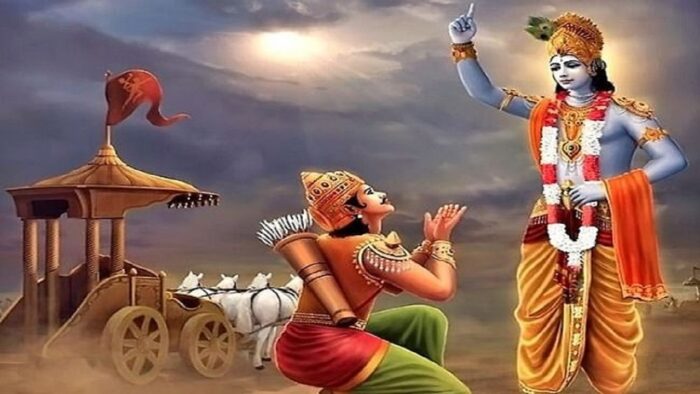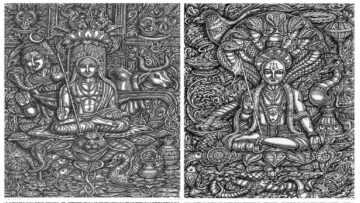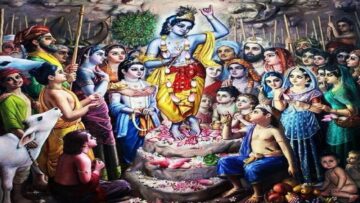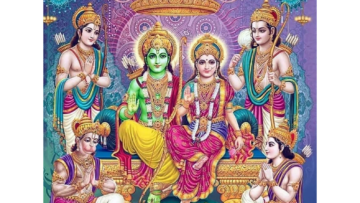Adhyeshyate cha ya imam dharmyam samvaadamaavayoh
Jnaanayajnena tenaaham ishtah syaamiti me matih // 18.70 //
Shraddhaavaan anasooyashcha shrinuyaadapi yo narah
so’pi muktah shubhaamllokaan praapnuyaat punyakarmanaam // 18.71 //
Translation:- And he who studies this sacred dialogue of ours, by him I would be worshipped through the Yajna of Knowledge; such is My conviction. Even the man who listens to it with faith and without malice; he too, being liberated, shall attain to the happy worlds of the righteous.
One of the fundamental aspects of Hinduism revolves around the spiritual paths one must take in order to reach the state of Moksh or enlightenment. As Moksh is the ultimate goal of human life; thereby liberating the soul from worldly bondages; it is obvious that concerns over the correct way to achieve this end are approached in a wide variety of ways which have been narrated in the chain of spiritual scriptures which have been produced since ages. In the above mentioned verses of Bhagwad Gita, Bhagwan Shri Krishna himself proclaims the importance of the subject as narrated by him. Gita has been accepted as a conclusionary teaching of all the Upanishads and Shastras and thus aims at spiritual emancipation of mankind. Therefore, infinite methods for attaining enlightenment/Moksh as narrated in Upanishads; finds conclusionary shelter in Bhagwad Gita. The entire knowledge of the cosmos is packed into the Gita. Supremely profound, yet couched in revelatory language of solacing beauty and simplicity; the Gita has been understood and applied on all the levels of human endeavor and spiritual striving – sheltering a vast spectrum of human beings and their disparate natures and needs. Path of Gita is the path of liberation which leads us from darkness to light and from a limited existence to limitlessness.
The timeless message of Gita, does not refer only to one historical battle of Kurukshetra but also to the cosmic conflict between the soul and the worldly bondages, between the good and evil, life as a series of battles between spirit and perishable matter, knowledge and ignorance, changelessness and transitoriness, self control and temptations, discriminised worldly outlook and the awakened eyesight. Bhagwad Gita therefore ultimately provides a bird view for a Karmyogi, a Gyaanyogi and Bhaktiyogi who should analyze their daily mental and physical actions to determine; just how much their life is ruled by the ego’s ignorance (delusion) and consciousness.
The Yogas that are spoken of in the Bhagwad Gita are in many ways interconnected. The term Yog refers to be attached with the supreme entity through any of the preferrable method as taught in scriptures. A commonly practiced approach to the Yogas is to choose one primary path to follow, while still observing the practices of the other Yogas in a secondary manner. While those who seek Moksha shall undoubtedly lean towards one particular path as true knowledge cannot be attained without at least a fundamental understanding of the remaining paths. An approach to the Yogas that has gained traction is understanding Bhakti, Karm, Rajyog, Sanyaasyog etc. prior to taking Gyaanyog to ensure that one has a real understanding of what it is that they learn and speak of along the path of knowledge. With the same purpose of encompassing all the varied methods of self realisation; Lord Krishna has prescribed various paths of self-realisation in Gita. Though these Yogas focus on different aspects of human life such as Gyanyog on knowledge, Karmyog on deeds, Bhaktiyog on love and devotion; but at the end all these means of spiritual upliftment seek the same goal; i.e. liberation of the soul.
The results which are likely to be achieved by the practice of these Yogas have been described in different verses of Bhagwad Gita. The expected results are stated to be attaining Brahm (The absolute entity) entering into him, attaining his state of being, remaining forever established in him and becoming eligible for being one with him. Similarly, in some verses attaining Krishna is stated to be the desired goal. Further, the goals which have been proclaimed in some other verses are attaining perfection, attaining supreme peace, immortality, enjoying infinite bliss, being free from worldly bondages, freedom from all the miseries arising from material contact, becoming eligible for eternal life, reaching the eternal and imperishable abode and reaching the state from where one is not born again. To put in simple words, aim of the all the Yogas as prescribed in Gita is to enable one to become unified in multiple ways in consciousness with the divine in him. This is what is called liberation or freedom of the soul. Anyone who has attained this state of transcendence is Yogi, a realised soul. He is ever present in the divine and divine is ever present in him.
The living entity engrossed in material nature, void of spiritual knowledge as explained in Vedic scriptures, considers the body as the self and seeks material pleasure as the only purpose of life. However, by receiving and understanding the transcendental knowledge from Gita, we obtain a new vision. Each and every human being has to fight his own spiritual battle of Kurukshetra; thereby resolving the internal never ending conflict. It is a war not only worth winning, but in the divine order of the universe regulated by almighty; he has to realize the eternal relationship between soul and God; a war that sooner or later must be won as per the teachings of almighty God himself. In the holy Bhagwad Gita, the quickest attainment of that victory is assured to the devotee, which is through undiscouragable practice of attaining ultimate refugee in Bhagwan as mentioned by him –
Devote your heart, mind, religious sacrifices and prayers to Me for eternity O Parth, and you shall without fail become a part of Me forever. This is My promise to you, My devotee. Detach yourself from all worldly things O Arjuna, and reach out to Me for your salvation and liberation from this world. I shall always protect you from all the worldly sins you may encounter. Put your full love, trust, and devotion in me and you shall fear nothing. (Bh.Gi.18/65-66)
Krishna guides Arjun through different levels of understanding the secrets of life. Nonetheless instructs us to act according to our level of realization. So ultimately Krishna explains through all the verses, that by executing the above processes of strictly controlling one’s mind and senses; one should try to reach the transcendental platform, which is free from all the dualities of material world. Situated in such transcendence, one should try to meditate upon the supreme lord with an unwavering mind. Such an elevated Yogi is always conscious of the supreme lord and considers everything around him in relation to the supreme entity. But the highest of all the yogis is one, who with great faith always abides by the supreme lord and constantly thinks of him within himself, rendering transcendental loving service unto him.
Practically our life can often seem like a battlefield; but it is also spoken of as a Drama, controlled by Bhagwan himself in Gita and when we look at it this way, we can ask ourselves; Am I playing my part fully? Are we each giving ourselves to our life and our world and living out purposefully? Bhagwad Gita thereby encourages us to live life with purity, strength, discipline, kindness and integrity in order to find our purpose and to live it fully. Just as Krishna encourages Arjun to cast aside all doubts and trust in his highest self, we too can use the wisdom of Gita to meet our own difficulties, understand our own self and take refuge in the almighty for attaining spiritual upliftment.
(Editor’s Note: Srimad Bhagavad Gita, the nectar of knowledge for mankind, spanning over 18 Parvas and 700 verses which are conversations between Bhagawan Srikrishna and Arjuna at the beginning of the Kurukshetra war, is an ultimate repository of spiritual wisdom. On the occasion of Gita Jayanti, we celebrate this ‘Divine Song of Bhagawan’ as even today it continues to inspire us and guide us with its relevance. With this, we are publishing the best articles that we received as part of our Gita Jayanti Competition.)
image credit: Prabhat Khabar
Disclaimer: The opinions expressed in this article belong to the author. Indic Today is neither responsible nor liable for the accuracy, completeness, suitability, or validity of any information in the article.










